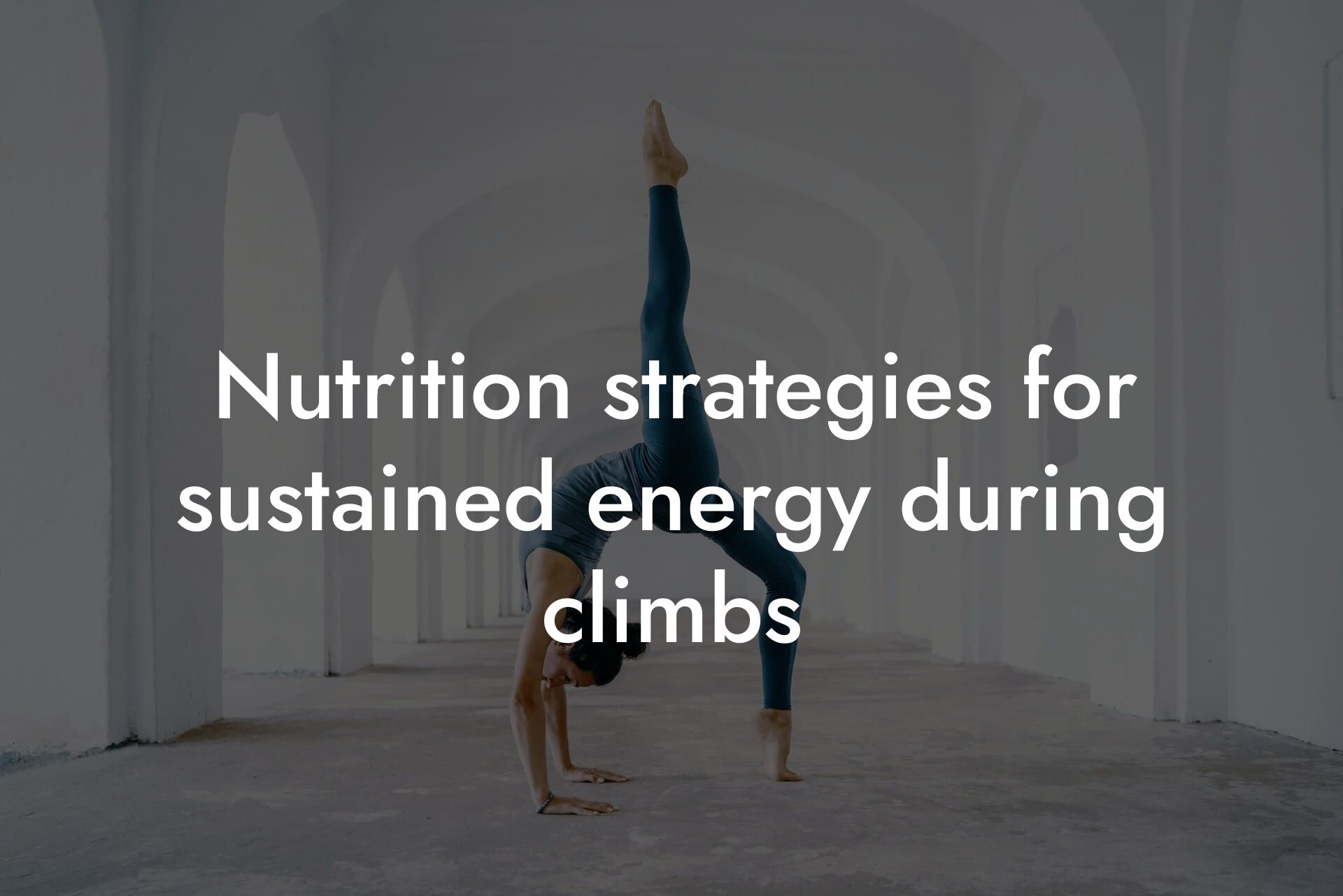As a climber, you understand the importance of having a strong and efficient body. Climbing requires a unique combination of power, endurance, and technique, and having the right physical attributes can make all the difference in your performance. One of the most critical factors in climbing strength is lean muscle mass. In this article, we'll explore the role of lean muscle mass in climbing, how it affects your performance, and what you can do to optimize your muscle mass for better climbing results.
Table of Contents
- What is Lean Muscle Mass?
- Why is Lean Muscle Mass Important for Climbing?
- How Does Lean Muscle Mass Affect Climbing Performance?
- How to Optimize Lean Muscle Mass for Climbing
- Common Mistakes Climbers Make When it Comes to Lean Muscle Mass
- Get a Complete Body Assessment with Tano Performance Group
- Frequently Asked Questions
What is Lean Muscle Mass?
Lean muscle mass refers to the amount of muscle tissue in your body that is not accompanied by excess fat. It's the amount of muscle you have that is functional and efficient, allowing you to move and perform at your best. Having a high percentage of lean muscle mass is essential for climbers, as it enables them to generate more power, strength, and endurance.
Why is Lean Muscle Mass Important for Climbing?
Lean muscle mass is critical for climbing because it allows you to generate the power and strength needed to pull yourself up, hold onto holds, and maintain your position on the wall. The more lean muscle mass you have, the more efficient you'll be at using oxygen and energy, which means you'll be able to climb for longer periods without getting tired. Additionally, lean muscle mass helps to improve your overall body composition, reducing your risk of injury and improving your overall health.
How Does Lean Muscle Mass Affect Climbing Performance?
Having a high percentage of lean muscle mass can significantly impact your climbing performance. Here are some ways in which lean muscle mass can affect your climbing:
- Increased Power and Strength: The more lean muscle mass you have, the more power and strength you'll be able to generate, allowing you to pull yourself up and hold onto holds with ease.
- Improved Endurance: Lean muscle mass helps to improve your endurance, allowing you to climb for longer periods without getting tired.
- Better Body Composition: Having a high percentage of lean muscle mass can help to improve your overall body composition, reducing your risk of injury and improving your overall health.
- Enhanced Technique: With more lean muscle mass, you'll be able to maintain better technique and form, which can help to reduce your risk of injury and improve your overall climbing efficiency.
How to Optimize Lean Muscle Mass for Climbing
Optimizing your lean muscle mass for climbing requires a combination of proper nutrition, training, and recovery. Here are some tips to help you get started:
- Focus on Protein-Rich Foods: Protein is essential for building and repairing muscle tissue, so make sure to focus on protein-rich foods such as lean meats, fish, eggs, and dairy products.
- Incorporate Strength Training: Incorporating strength training into your workout routine can help to build lean muscle mass and improve your overall climbing performance.
- Get Enough Rest and Recovery: Adequate rest and recovery are essential for building and repairing muscle tissue, so make sure to get enough sleep and take rest days as needed.
- Monitor Your Body Composition: Regularly monitoring your body composition using a DEXA scan or other methods can help you track your progress and make adjustments to your training and nutrition plan as needed.
Common Mistakes Climbers Make When it Comes to Lean Muscle Mass
When it comes to optimizing lean muscle mass for climbing, there are several common mistakes that climbers make. Here are a few to avoid:
- Not Eating Enough Protein: Failing to consume enough protein can limit your ability to build and repair muscle tissue, which can negatively impact your climbing performance.
- Not Incorporating Strength Training: Failing to incorporate strength training into your workout routine can limit your ability to build lean muscle mass and improve your overall climbing performance.
- Not Getting Enough Rest and Recovery: Failing to get enough rest and recovery can limit your ability to build and repair muscle tissue, which can negatively impact your climbing performance.
In conclusion, lean muscle mass plays a critical role in climbing strength and performance. By understanding the importance of lean muscle mass, how it affects your climbing performance, and how to optimize it, you can take your climbing to the next level. Remember to focus on protein-rich foods, incorporate strength training, get enough rest and recovery, and monitor your body composition to ensure you're on the right track.
Get a Complete Body Assessment with Tano Performance Group
At Tano Performance Group, we understand the importance of having a complete understanding of your body composition. That's why we offer DEXA scans and other body assessment tools to help you track your progress and optimize your training and nutrition plan. Contact us today to learn more about how we can help you take your climbing to the next level.
Frequently Asked Questions
What is lean muscle mass and why is it important for climbing strength?
Lean muscle mass refers to the amount of muscle tissue in your body that is not fat. It is essential for climbing strength because it provides the power and endurance needed to overcome obstacles and sustain long climbs. Having a higher percentage of lean muscle mass can improve your overall climbing performance and reduce your risk of injury.
How does lean muscle mass contribute to climbing strength?
Lean muscle mass plays a crucial role in climbing strength by providing the force and power needed to pull, push, and hold your body weight. It also helps to improve your endurance, allowing you to sustain long climbs and recover quickly between routes.
What is the ideal percentage of lean muscle mass for climbers?
The ideal percentage of lean muscle mass for climbers varies depending on factors such as age, sex, and climbing style. Generally, a lean muscle mass percentage of 30-40% for men and 25-35% for women is considered optimal for climbing performance.
How can I increase my lean muscle mass for climbing?
To increase your lean muscle mass for climbing, focus on a combination of strength training, nutrition, and recovery. Incorporate exercises that target multiple muscle groups, such as squats, deadlifts, and pull-ups, and aim to eat a calorie-surplus diet that includes plenty of protein.
What are the benefits of having more lean muscle mass for climbing?
Having more lean muscle mass can improve your climbing performance by increasing your power, endurance, and overall strength. It can also reduce your risk of injury and improve your body composition, leading to a more athletic physique.
Can I still climb well with a low percentage of lean muscle mass?
While having a low percentage of lean muscle mass may not be ideal for climbing, it is still possible to climb well with proper technique, training, and strategy. Focus on developing your technique, building your endurance, and using your body weight efficiently to overcome obstacles.
How does body fat percentage affect climbing performance?
Having a high body fat percentage can negatively impact climbing performance by reducing your power-to-weight ratio and increasing your energy expenditure. Aim to maintain a body fat percentage of 10-20% for optimal climbing performance.
What is the relationship between bone density and climbing performance?
Bone density is crucial for climbing performance as it provides the structural integrity needed to support your body weight and withstand the forces generated during climbing. Having high bone density can reduce your risk of injury and improve your overall climbing performance.
How can I improve my bone density for climbing?
To improve your bone density for climbing, incorporate weight-bearing exercises, such as squats and deadlifts, into your training program. Also, ensure you are getting adequate calcium and vitamin D through your diet or supplements.
What role does nutrition play in building lean muscle mass for climbing?
Nutrition plays a critical role in building lean muscle mass for climbing. Aim to consume a calorie-surplus diet that includes plenty of protein, complex carbohydrates, and healthy fats. Additionally, ensure you are getting adequate vitamins and minerals, such as vitamin D and calcium, to support muscle growth and bone health.
How much protein do I need to consume to build lean muscle mass for climbing?
Aim to consume 1.2-1.6 grams of protein per kilogram of body weight daily to support muscle growth and repair. This can be achieved through a combination of whole foods, such as lean meats and fish, and supplements, such as protein powder.
What are the best exercises for building lean muscle mass for climbing?
The best exercises for building lean muscle mass for climbing are those that target multiple muscle groups, such as squats, deadlifts, pull-ups, and lunges. These exercises can help improve your overall strength, power, and endurance.
How often should I train to build lean muscle mass for climbing?
Aim to train 3-4 times per week, with at least one day of rest in between, to build lean muscle mass for climbing. This can include a combination of strength training, cardio, and active recovery, such as yoga or stretching.
What is the importance of recovery in building lean muscle mass for climbing?
Recovery is crucial in building lean muscle mass for climbing as it allows your muscles to repair and rebuild. Ensure you are getting adequate sleep, 7-9 hours per night, and incorporating recovery techniques, such as foam rolling and stretching, into your training program.
Can I build lean muscle mass for climbing without weights?
Yes, it is possible to build lean muscle mass for climbing without weights. Bodyweight exercises, such as pull-ups, push-ups, and squats, can be effective in improving your strength and muscle mass. Additionally, incorporating resistance band exercises can provide an additional challenge.
How long does it take to see results from training for lean muscle mass for climbing?
Results from training for lean muscle mass for climbing can vary depending on factors such as training program, nutrition, and genetics. However, with consistent training and proper nutrition, you can start to see noticeable improvements in 6-12 weeks.
What are the risks of overtraining for lean muscle mass for climbing?
Overtraining can lead to fatigue, injury, and decreased performance. Ensure you are listening to your body and incorporating rest days into your training program to avoid overtraining.
How can I track my progress in building lean muscle mass for climbing?
Track your progress by taking body measurements, weight, and body fat percentage regularly. Additionally, monitor your performance on climbs, such as your route completion time and overall strength.
What are the benefits of working with a personal trainer or coach for building lean muscle mass for climbing?
Working with a personal trainer or coach can provide personalized guidance, accountability, and support in building lean muscle mass for climbing. They can help you develop a customized training program, provide nutrition guidance, and offer technique correction.
How can I incorporate climbing-specific exercises into my training program?
Incorporate climbing-specific exercises, such as campus boards, hangboards, and pull-up bars, into your training program to improve your climbing-specific strength and endurance.
What is the importance of flexibility and mobility for climbing?
Flexibility and mobility are crucial for climbing as they allow for efficient movement and reduce the risk of injury. Incorporate stretching and mobility exercises, such as yoga and foam rolling, into your training program.
How can I balance my training program with other aspects of my life?
Balance your training program with other aspects of your life by prioritizing your goals, setting realistic expectations, and incorporating time-management strategies, such as scheduling your workouts and meal planning.
What are the benefits of joining a climbing community or gym for building lean muscle mass for climbing?
Joining a climbing community or gym can provide access to climbing-specific training equipment, guidance from experienced climbers, and a supportive community to help motivate and inspire you to reach your goals.
Here are some related articles you might love...
- Using DEXA scans to monitor progress in climbing
- The impact of body composition on climbing performance
- Nutrition strategies for sustained energy during climbs
- Off-season training strategies for climbers
- Balancing strength, endurance, and flexibility in climbing
- Recovery techniques for climbers after intense sessions
- Strength training programs for amateur climbers
- Reducing body fat for better climbing efficiency
- Bone density and injury prevention in climbing
Zak Faulkner
Zak Faulkner is a leading authority in the realm of physical health and body composition analysis, with over 15 years of experience helping professionals optimise their fitness and well-being. As one the experts behind Tano Performance Group, Zak has dedicated his career to providing in-depth, science-backed insights that empower clients to elevate their physical performance and overall health.
With extensive knowledge of DEXA technology, Zak specializes in delivering comprehensive body assessments that offer precise data on body fat, muscle mass, bone density, and overall physique. His expertise enables individuals to make informed decisions and achieve their fitness goals with accuracy and confidence. Zak’s approach is rooted in a deep understanding of human physiology, combined with a passion for helping clients unlock their full potential through personalised strategies.
Over the years, Zak has earned a reputation for his commitment to excellence, precision, and client-focused service. His guidance is trusted by top professionals who demand the best when it comes to their health. Whether advising on fitness programs, nutritional strategies, or long-term wellness plans, Zak Faulkner’s insights are a valuable resource for anyone serious about taking their health and fitness to the next level.
At Tano Performance Group, Zak continues to lead our Content Team revolutionising how professionals approach their physical health, offering unparalleled expertise that drives real results.




